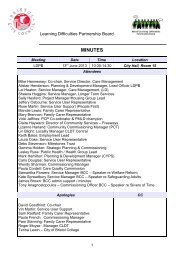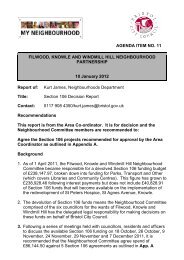7. draft police and crime needs assessment
7. draft police and crime needs assessment
7. draft police and crime needs assessment
Create successful ePaper yourself
Turn your PDF publications into a flip-book with our unique Google optimized e-Paper software.
AGENDA ITEM: 7<br />
AVON AND SOMERSET POLICE AND CRIME PANEL<br />
REPORT OF THE AVON & SOMERSET POLICE AND CRIME COMMISSIONER<br />
24 OCTOBER 2013<br />
POLICE AND CRIME NEEDS ASSESSMENT 2013 - UPDATE<br />
Introduction<br />
This report provides an update on progress towards developing the Avon <strong>and</strong><br />
Somerset Police <strong>and</strong> Crime Needs Assessment 2013. The Assessment is being<br />
developed in consultation with key stakeholders to inform the Police <strong>and</strong> Crime Plan<br />
refresh for 2014-1<strong>7.</strong><br />
Background<br />
The first Avon <strong>and</strong> Somerset wide partnership Police <strong>and</strong> Crime Needs Assessment<br />
(PCNA) was produced in 2012. The process brought together research, analysis,<br />
knowledge <strong>and</strong> intelligence across the Avon <strong>and</strong> Somerset in order to present a<br />
consolidated picture of the issues, risks <strong>and</strong> threats shared by respective agencies.<br />
The document was used primarily to inform policy development <strong>and</strong> strategic<br />
planning for 2013-17 <strong>and</strong> provide prospective Police <strong>and</strong> Crime Commissioners with<br />
a shared underst<strong>and</strong>ing of the local <strong>crime</strong> <strong>and</strong> community safety environment.<br />
A refresh of the Police <strong>and</strong> Crime Needs Assessment is currently underway, building<br />
upon the process initiated in 2012 <strong>and</strong> maximising opportunities brought about by<br />
the new <strong>police</strong> <strong>and</strong> partnership environment. The OPCC continues to develop more<br />
integrated planning arrangements with the Constabulary <strong>and</strong> OPCC <strong>and</strong> closer<br />
working relationships with key partners in Health, the Voluntary <strong>and</strong> Community<br />
sector through this process.<br />
The Police <strong>and</strong> Crime Needs Assessment comprises two main elements:-<br />
a) An <strong>assessment</strong> of the issues, risks <strong>and</strong> threats that are likely to impact upon<br />
<strong>crime</strong> <strong>and</strong> community safety services across Avon <strong>and</strong> Somerset between 2013<br />
<strong>and</strong> 2017<br />
b) A profile of local need for <strong>crime</strong> <strong>and</strong> community safety services with a focus on<br />
specific areas of commissioning responsibility <strong>and</strong> the commissioner’s <strong>police</strong><br />
<strong>and</strong> <strong>crime</strong> priorities.<br />
Both aspects of the <strong>assessment</strong> will be used to inform commissioning decisions<br />
across Avon <strong>and</strong> Somerset over the coming three years.<br />
1
Initial findings<br />
Preliminary findings from the 2013 PCNA indicate that the current priorities remain<br />
relevant <strong>and</strong> supported by multi-agency focus. Momentum is also gathering in<br />
response to these priorities, with some early successes already evident.<br />
The PCNA highlights a number of significant areas of risk <strong>and</strong> aspects of service that<br />
that could be strengthened within the 2014-17 Police <strong>and</strong> Crime Plan. They include:-<br />
• Work to engage <strong>and</strong> empower communities to resolve issues of local<br />
concern - particularly with regard to ASB, road safety <strong>and</strong> reducing <strong>crime</strong>s of<br />
local concern<br />
• Improving the combined partnership focus on tackling issues <strong>and</strong> areas of<br />
greatest need – despite significant activity, there is currently no strategic coordinated<br />
focus on priority areas <strong>and</strong> neighbourhoods<br />
• Safeguarding from serious harm – ensuring clarity of agency roles <strong>and</strong><br />
responsibilities <strong>and</strong> improving picture of risk, particularly by improving victim<br />
<strong>and</strong> third party reporting, community intelligence, information sharing <strong>and</strong><br />
research <strong>and</strong> analysis<br />
• Young people - increase confidence <strong>and</strong> engagement with young people <strong>and</strong><br />
review <strong>and</strong> respond to gaps in services.<br />
• Tackling organised criminality <strong>and</strong> keeping ahead of new criminal<br />
opportunities, particularly with regard to advances in technology <strong>and</strong> social<br />
networking<br />
• Prevention-focus to reduce potential harm <strong>and</strong> dem<strong>and</strong> – including coordinated<br />
responses to gaps in treatment <strong>and</strong> diversionary activities, <strong>and</strong><br />
tackling the drivers <strong>and</strong> facilitators of offending, particularly<br />
The more comprehensive summary of the <strong>draft</strong> Police <strong>and</strong> Crime Needs Assessment<br />
findings is shown at Annex 1.<br />
Next Steps<br />
The OPCC is currently consulting key partners on the content <strong>and</strong> recommendations<br />
of the <strong>draft</strong> Police <strong>and</strong> Crime Needs Assessment 2013 in preparation for a final <strong>draft</strong>,<br />
which will be presented to a Partner <strong>and</strong> Practitioner Event on 30 th October.<br />
The Partner <strong>and</strong> Practitioner event will include representation from partners across<br />
<strong>police</strong>, community safety, criminal justice, public health, Clinical Commissioning<br />
Groups, community <strong>and</strong> voluntary sector <strong>and</strong> the Police <strong>and</strong> Crime Panel. It will be<br />
an interactive session <strong>and</strong> provide an opportunity to:<br />
2<br />
• Review, discuss <strong>and</strong> consolidate key findings<br />
• Consider next steps <strong>and</strong> multi-agency responses to the issues identified<br />
• Set out the Commissioner’s approach to the Police <strong>and</strong> Crime Plan refresh
• Update partners on key Change Programme / Operating Model developments<br />
The outputs of this event will be used to support the refresh of the Police <strong>and</strong> Crime<br />
Plan. A summary of key milestones is shown below.<br />
• September – October Partnership consultation PCNA<br />
• 30 th October 2013 Partner <strong>and</strong> Practitioner Event<br />
• October – January Refresh Force Police <strong>and</strong> Crime Plans<br />
• November – February Develop Local Authority Police <strong>and</strong> Crime Plans<br />
• 8 th November 2013 Force-level & local plan template<br />
• 22 nd November 2013 First <strong>draft</strong> force level plan<br />
• 29 th November 2013 Police <strong>and</strong> Crime Plan Workshop<br />
• 17 th January 2014 First <strong>draft</strong> local authority-level plans submitted<br />
• 22 nd January 2014 Review group considers <strong>draft</strong> plans / feedback<br />
• 5 th February 2014 Police <strong>and</strong> Crime Panel review <strong>draft</strong> plan<br />
• 7 th February 2014 Finalise local plans<br />
• 10 th Feb – 10 th Mar Public <strong>and</strong> partner consultation on revised plan<br />
• 21 st March 2014 Police <strong>and</strong> Crime Panel ratify plan<br />
• March – April 2014 Issue <strong>and</strong> publicise Police <strong>and</strong> Crime Plans<br />
Recommendations<br />
The panel is asked to note the report <strong>and</strong> key milestones <strong>and</strong> co-ordinate feedback<br />
on the <strong>draft</strong> Police <strong>and</strong> Crime Needs Assessment via the nominated representative.<br />
3
ANNEX A. DRAFT POLICE AND CRIME NEEDS ASSESSMENT EXECUTIVE SUMMARY<br />
The Avon <strong>and</strong> Somerset Police <strong>and</strong> Crime Needs Assessment 2013 has been developed in collaboration<br />
with local <strong>crime</strong> <strong>and</strong> community safety partner agencies. The <strong>assessment</strong> outlines key issues, risks <strong>and</strong><br />
threats that are likely to impact upon t he <strong>crime</strong> <strong>and</strong> community safety environment between 2014 <strong>and</strong><br />
201<strong>7.</strong> Findings should be used to inform planning <strong>and</strong> policy development for 2014, including the refresh<br />
of force <strong>and</strong> Local Authority level Police <strong>and</strong> Crime Plans.<br />
Key Points<br />
• The long terms overall risk of <strong>crime</strong> <strong>and</strong> anti-social behaviour continues to fall across Avon <strong>and</strong><br />
Somerset, as does overall dem<strong>and</strong> on <strong>crime</strong> <strong>and</strong> community safety agencies.<br />
• Changing economic trends, extensive welfare reform <strong>and</strong> c uts to key services, however, create<br />
potential for increased risk of offending <strong>and</strong> victimisation, particularly amongst young people <strong>and</strong><br />
deprived communities. There clear opportunities to improve local preventative activity.<br />
• Safeguarding dem<strong>and</strong>s, particularly in relation to mental health, are increasing as a result of growing<br />
need, improvements in risk <strong>assessment</strong> <strong>and</strong> intelligence, <strong>and</strong> reductions in statutory provision of<br />
social care. There are opportunities improve early intervention <strong>and</strong> agency responses.<br />
• Unreported <strong>crime</strong>s <strong>and</strong> unmet need often carry the greatest potential risk to vulnerable victims,<br />
particularly in areas such as domestic <strong>and</strong> s exual violence <strong>and</strong> exploitation, hate <strong>crime</strong>, human<br />
trafficking <strong>and</strong> genital mutilation. Young people, women <strong>and</strong> people from black <strong>and</strong> minority ethnic<br />
communities are at disproportionately high risk of victimisation for these offence types. More can be<br />
done to build confidence amongst victims, witnesses <strong>and</strong> other third parties to reporting such cases<br />
• Technological development <strong>and</strong> t he growth of social media have led to a r apid increase in risks<br />
relating to cyber-<strong>crime</strong>, cyber-enabled <strong>crime</strong>, sexual exploitation, stalking, harassment <strong>and</strong> c yberbullying.<br />
Community-level intelligence <strong>and</strong> technical capability are critical in tackling these issues.<br />
• Organised criminality remains a primary driver of serious <strong>crime</strong>, harm <strong>and</strong> hidden harm with<br />
technological, social <strong>and</strong> economic conditions creating new opportunities for markets in stolen <strong>and</strong><br />
counterfeit goods, drug distribution, domestic extremism <strong>and</strong> ex ploitation in particular. Although<br />
resource intensive, disrupting <strong>and</strong> dismantling of organised <strong>crime</strong> can have far reaching benefits.<br />
• Alcohol <strong>and</strong> drugs remain primary drivers of dem<strong>and</strong>, particularly in Bristol, <strong>and</strong> a shared partnership<br />
priority, despite gaps in co-ordinated agency responses. Harm related to the use of ‘legal’ <strong>and</strong> illegal<br />
drugs continues to drive risk <strong>and</strong> concern amongst vulnerable communities.<br />
• The public’s priorities <strong>and</strong> expectations are clear <strong>and</strong> have remained relatively unchanged over time.<br />
Anti-social behaviour, speeding traffic <strong>and</strong> parking are notable drivers of dem<strong>and</strong> <strong>and</strong> the community<br />
safety issues with the most significant daily impact on local communities. Mo re can be don e to<br />
develop an underst<strong>and</strong>ing of the extent to which these issues are being resolved <strong>and</strong> to support <strong>and</strong><br />
empower local communities to take action.<br />
• Burglary <strong>and</strong> domestic <strong>and</strong> sexual violence are high impact <strong>crime</strong>s which levels of concern amongst<br />
local residents. Re-offending also remains a s hared partnership priority particularly in the<br />
management of prolific <strong>and</strong> high impact offenders. National changes to commissioning<br />
arrangements, however, may present challenges to offender management <strong>and</strong> information sharing.<br />
• The Criminal Justice System is operating at capacity <strong>and</strong> delivery of the efficiency programme to<br />
digitise <strong>and</strong> integrate technology, improve in case file quality <strong>and</strong> make appropriate <strong>and</strong><br />
proportionate use of restorative justice <strong>and</strong> community disposals will be critical to improving<br />
outcomes for victims.<br />
• Critical challenges facing <strong>crime</strong>, community safety <strong>and</strong> criminal justice agencies include reducing<br />
budgets, the changing commissioning l<strong>and</strong>scape <strong>and</strong> maintaining <strong>and</strong> improving the public’s trust<br />
<strong>and</strong> confidence.<br />
• Avon <strong>and</strong> Somerset’s population continues to grow <strong>and</strong> diversify. This presents challenges to service<br />
providers in providing visible neighbourhood services, maintaining an awareness of local culture <strong>and</strong><br />
<strong>needs</strong>, <strong>and</strong> ensuring equality of access to key services<br />
4
Cross Cutting Themes<br />
The <strong>assessment</strong> identifies a n umber of cross-cutting themes which are central to delivering improved<br />
outcomes for victims of <strong>crime</strong> <strong>and</strong> ASB in Avon <strong>and</strong> Somerset. They include:-<br />
5<br />
• Partnership working - with a focus on the most problematic issues, cases <strong>and</strong> localities viewed as o<br />
one of the main drivers of <strong>crime</strong> reduction over recent years, highlighting the benefits of a sustained<br />
commitment to key multi-agency partnership approaches (integrated offender management, troubled<br />
families). There are significant opportunities to extend these principles in areas such as case <strong>and</strong><br />
risk management.<br />
• Prevention focus – There are significant opportunities to improve the coverage <strong>and</strong> co-ordination of<br />
local preventative services (youth diversion, Bobby Van, targeted education, advice <strong>and</strong> signposting)<br />
<strong>and</strong> make wider use of predictive analytics to inform resource allocation.<br />
• Information, analysis <strong>and</strong> research – Developing a holistic picture, capturing intelligence, ensuring<br />
victims receive the services they need <strong>and</strong> maximising safeguarding opportunities all rely on the<br />
accurate recording of data. There are clear opportunities to improve quality, consistency <strong>and</strong> sharing<br />
of information <strong>and</strong> invest in research <strong>and</strong> analysis to improve underst<strong>and</strong>ing of hidden harm<br />
• Cross-agency co-ordination <strong>and</strong> strategic planning can significantly improve the management of risk<br />
<strong>and</strong> dem<strong>and</strong> across agencies <strong>and</strong> reduce duplication of effort. This will be particularly important in<br />
responding to changes in offender management commissioning arrangements <strong>and</strong> managing<br />
dem<strong>and</strong> within the criminal justice system.<br />
• Reviewing roles, responsibilities, commitments at individual, agency <strong>and</strong> multi-agency levels,<br />
particularly with a view to effectively managing dem<strong>and</strong> at first point of contact. This may include<br />
extending the remit of the <strong>police</strong> to prosecute certain specified offences <strong>and</strong> broadening role profiles<br />
to provide a more seamless service for victims of <strong>crime</strong> <strong>and</strong> ASB<br />
• Young people remain the group most vulnerable to offending, victimisation, harm <strong>and</strong> serious harm.<br />
They are also a group significantly less likely to report their victimisation or trust the <strong>police</strong>.<br />
Key Recommendations<br />
• Develop <strong>and</strong> improve processes for engaging <strong>and</strong> empowering communities to resolve<br />
issues of local concern, particularly with regard to ASB <strong>and</strong> road safety. Improve the<br />
underst<strong>and</strong>ing of outcomes being delivered for the public in these areas <strong>and</strong> use the commissioning<br />
process to ensure partnership activity is targeted in areas of greatest need. Foster improvements in<br />
partnership working <strong>and</strong> embed a culture of shared responsibility.<br />
• Increase focus on safeguarding from serious harm. Invest in underst<strong>and</strong>ing risk, prevalence <strong>and</strong><br />
hidden harm by improving victim <strong>and</strong> t hird party reporting, commissioning research <strong>and</strong> an alysis<br />
supporting improvements in information sharing <strong>and</strong> community intelligence. Ensure agency roles<br />
<strong>and</strong> responsibilities are clearly defined <strong>and</strong> ensure that appropriate action is taken at the first point of<br />
contact to prevent dem<strong>and</strong> upstream. Work to established shared definition <strong>and</strong> approaches to<br />
vulnerable victims. Increase confidence <strong>and</strong> engagement with young people. I nvest in technology<br />
<strong>and</strong> expertise to keep ahead of new criminal opportunities.<br />
• Build <strong>and</strong> retain capacity <strong>and</strong> resilience particularly in maximising opportunities to collaborate <strong>and</strong><br />
integrate services. Implement impact <strong>assessment</strong>s where decisions to retract or cease services are<br />
likely to impact significantly on the delivery of shared outcomes. Develop a co-ordinated framework<br />
to identify <strong>and</strong> share good practice <strong>and</strong> gaps in training <strong>and</strong> collectively plan for changing dem<strong>and</strong>.<br />
• Invest in prevention to reduce potential harm <strong>and</strong> dem<strong>and</strong>. T ackle drivers <strong>and</strong> f acilitators of<br />
offending, particularly alcohol <strong>and</strong> organised <strong>crime</strong>. Review <strong>and</strong> respond to gaps in treatment <strong>and</strong><br />
diversionary activities, particularly for young people. Support pro-active target hardening <strong>and</strong> new<br />
technologies for predicting victimisation. Engage communities in <strong>crime</strong> reduction.<br />
• Improve confidence in <strong>and</strong> the victim experience of the Criminal Justice System. Focus, in<br />
particular on keeping victims informed, improving efficiency <strong>and</strong> effectiveness within the Criminal<br />
Justice System, reducing re-offending: <strong>and</strong> maximising available enforcement tools<br />
More specific conclusions <strong>and</strong> recommendations are set out in each substantive chapter of the full Police<br />
<strong>and</strong> Crime Needs Assessment.
















